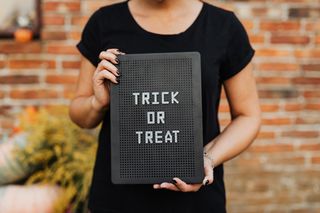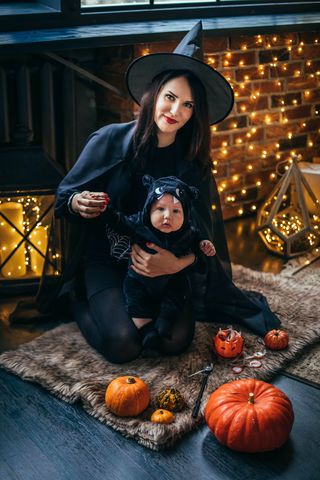Gender
Do Ads for Sexy Halloween Costumes Target Young Girls?
New research shows how Halloween costume ads sexualize children and teens.
Posted October 7, 2020 Reviewed by Gary Drevitch

As Halloween approaches, a familiar parade of women’s costumes appears in advertisements: Sexy nurse. Sexy cat. Sexy witch. While costumes designed for men lean toward the powerful, the humorous, or the horrific, the sexualization of women’s Halloween costumes is so entrenched that the line between irony and sex appeal may be blurred at this point. Sexy cauliflower pizza? Sexy mail-in ballot? Although opinion pieces bemoaning (or mocking) this trend appear each year, a systematic analysis of Halloween costumes had not yet been conducted. New research out of Oregon State University fills this gap, examining just how far this gendered trend in Halloween costumes goes. After analyzing over a thousand costume ads from four major online retailers, the authors concluded that the gender gap in the sexualization of Halloween costumes doesn’t just show up in costumes designed for adults; sexualized costumes and models regularly appeared in ads showing costumes for young girls and teenage girls.
Over 10 years ago, the American Psychological Association published a landmark task force report on the sexualization of girls. The report concluded that mass media messages (like sexualized images of women in schoolgirl outfits) and merchandise (like Bratz dolls or thongs sized for 7-to-10-year-olds) encourage the sexualization of girls. Further, the APA argued that these forces pose a threat to girls’ physical and mental health. Sexualization can take different forms. A person who is only valued for their sexual attractiveness has been sexualized, as has someone who is treated as a “thing” to be used by others. Most relevant to this new study, psychologists view having sexuality inappropriately imposed on you (in this case, when it is age-inappropriate) as a harmful type of sexualization.
In this new research, the authors conducted an in-depth content analysis of advertisements for Halloween costumes. They were most interested in whether the markers of sexualization varied by the gender and age group targeted by the advertisements. First, the researchers identified four of the top online retailers of Halloween costumes (Walmart, Costume Express, Chasing Fireflies, and HalloweenCostumes.com). After taking screenshots of over 14,000 costumes (excluding costumes designed for infants), the authors randomly selected costumes from each age category (child, teen, adult) and gender category. Costumes in which the targeted gender was not clearly male or female (7% of the coded images) were not included in the analyses. The authors then examined the costumes, the accompanying text, and the models.

Costumes were reviewed for elements like tightness, cutaways, and a focus on sexualized body parts, and coded as sexualized if multiple elements were present. The authors also coded whether the “role” of the costume identified by the retailer was sexualized. This would include costumes like “French maid” or schoolgirl costumes for adult women, as well costumes with words like “sexy,” “red hot,” “erotic,” or “flirty” in their titles. The authors also counted costumes accompanied by sexualized text or innuendo – for example, a costume accompanied by the copy, “Have you been an awful good girl? Mister Kringle will be aching to hurry down your chimney tonight!” Finally, the authors examined the models of the costumes for sexualized cues—for example, the amount of skin showing or the pose.
Not surprisingly, costumes targeted at women were significantly more likely to be sexualized, as were the models wearing them. Despite including terms like “stud” or “Adonis” designed to capture sexualization of male models, the only costumes identified explicitly in a sexual way (e.g., pin-up girl, sexy maid) were targeted at women. Overall, sexualization was low for male models across the age spectrum.
Costumes worn by child models were rated as less sexualized than those worn by teen or adult models. However, teen girl and adult women’s costumes did not differ in rates of sexualization, suggesting a downward “creep” of sexualized cues into costumes targeting adolescent girls. Though overtly sexualized children’s costumes were not common, they were still substantially more likely to appear in girls’ sections of websites compared to boys’. Girl models were also more likely than boy models to wear sexualized costumes and be posed in sexualized ways.
Overall, the study’s findings point toward what researchers call “age compression.” This is a worrisome trend in which adult-like characteristics are foisted upon increasingly younger age groups. In addition to finding that costumes targeting adolescent girls were often sexualized, the authors also note that many teens will shop in the adult sections of online costume retailers, making it even more likely that their options will include many hypersexualized costumes.

The researchers suggest that parents use the selection of a Halloween costume as an opportunity to have conversations with children about the differences between age-appropriate sexual curiosity and the sexualization of oneself or of others. Parents could discuss how male and female models seem to have different types of poses and costumes, and encourage children to think about the messages these patterns send about what is valued in girls vs. boys (and women vs. men). Parents can also encourage children of all genders to use costumes as a means of exploring and expressing creativity rather than an opportunity to “perform sexiness” for others.


